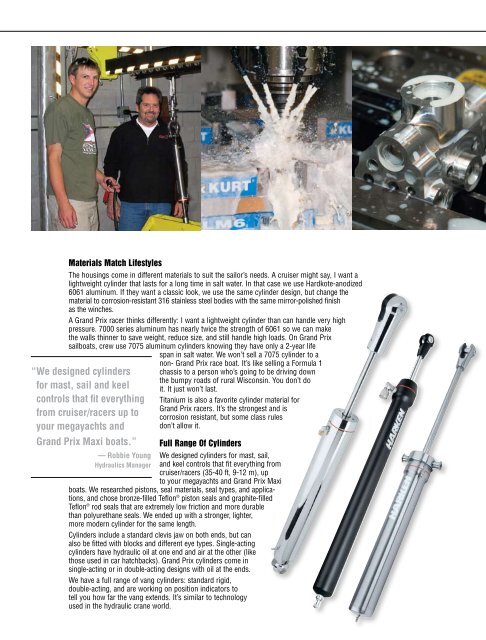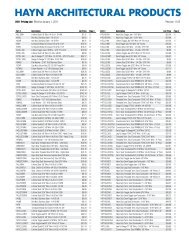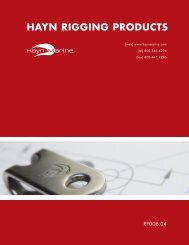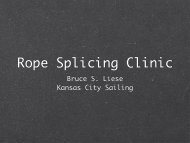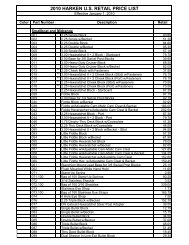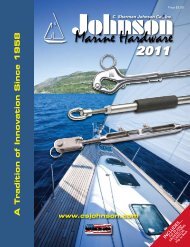2009 - 2010
Harken_Catalogue_201.. - Kansas City Sailing
Harken_Catalogue_201.. - Kansas City Sailing
- No tags were found...
You also want an ePaper? Increase the reach of your titles
YUMPU automatically turns print PDFs into web optimized ePapers that Google loves.
Materials Match Lifestyles<br />
The housings come in different materials to suit the sailor’s needs. A cruiser might say, I want a<br />
lightweight cylinder that lasts for a long time in salt water. In that case we use Hardkote-anodized<br />
6061 aluminum. If they want a classic look, we use the same cylinder design, but change the<br />
material to corrosion-resistant 316 stainless steel bodies with the same mirror-polished finish<br />
as the winches.<br />
A Grand Prix racer thinks differently: I want a lightweight cylinder than can handle very high<br />
pressure. 7000 series aluminum has nearly twice the strength of 6061 so we can make<br />
the walls thinner to save weight, reduce size, and still handle high loads. On Grand Prix<br />
sailboats, crew use 7075 aluminum cylinders knowing they have only a 2-year life<br />
span in salt water. We won’t sell a 7075 cylinder to a<br />
“We designed cylinders<br />
for mast, sail and keel<br />
controls that fit everything<br />
from cruiser/racers up to<br />
your megayachts and<br />
Grand Prix Maxi boats.”<br />
— Robbie Young<br />
Hydraulics Manager<br />
non- Grand Prix race boat. It’s like selling a Formula 1<br />
chassis to a person who’s going to be driving down<br />
the bumpy roads of rural Wisconsin. You don’t do<br />
it. It just won’t last.<br />
Titanium is also a favorite cylinder material for<br />
Grand Prix racers. It’s the strongest and is<br />
corrosion resistant, but some class rules<br />
don’t allow it.<br />
Full Range Of Cylinders<br />
We designed cylinders for mast, sail,<br />
and keel controls that fit everything from<br />
cruiser/racers (35-40 ft, 9-12 m), up<br />
to your megayachts and Grand Prix Maxi<br />
boats. We researched pistons, seal materials, seal types, and applications,<br />
and chose bronze-filled Teflon ® piston seals and graphite-filled<br />
Teflon ® rod seals that are extremely low friction and more durable<br />
than polyurethane seals. We ended up with a stronger, lighter,<br />
more modern cylinder for the same length.<br />
Cylinders include a standard clevis jaw on both ends, but can<br />
also be fitted with blocks and different eye types. Single-acting<br />
cylinders have hydraulic oil at one end and air at the other (like<br />
those used in car hatchbacks). Grand Prix cylinders come in<br />
single-acting or in double-acting designs with oil at the ends.<br />
We have a full range of vang cylinders: standard rigid,<br />
double-acting, and are working on position indicators to<br />
tell you how far the vang extends. It’s similar to technology<br />
used in the hydraulic crane world.


